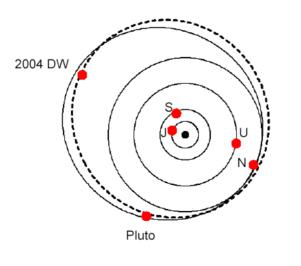The object approaches the Sun until the orbit of Neptune and recedes until the orbit of Pluto and is the largest of the 15 planetoids discovered so far

Astronomers announced last Thursday that they found an icy object at a distance of about 7 billion kilometers from the Sun, which appears to be about half the size of Pluto and is larger than Pluto's moon. If the discovery is confirmed, it would be the largest planetoid-type object found in our solar system since Pluto itself was discovered in 1930.
Preliminary observations of the object suggest that the frozen celestial body is ten percent larger than "Kva-Var", an object with a diameter of about 1,350 km that was discovered in 2002.
"Currently, it appears to be greater thanKwa-War, which places it as larger than anything else at the end of the solar system apart from Pluto." said Mike Brown, an astronomer at the California Institute of Technology.
Brown and his colleagues Chad Trujillo of the Gemini Observatory in Hawaii and David Rabinowitz of Yale University discovered the object last Monday using the Palomar Observatory, which is outside San Diego.
The object, so far known as 2004 DW, lies in the outer part of the Kuiper Belt, a region of icy rocks beyond Neptune's orbit. Pluto is the largest known object in the Kuiper Belt, although it has traditionally been considered a planet. The diameter of its moon, Charon, is about 1,250 kilometers. The new object is the 15th in a series of objects over 500 kilometers in size, found in this area.
Preliminary measurements suggest that the object moves in an elliptical orbit around the Sun, in which it approaches it to a distance of about 4.3 billion kilometers and moves away from it up to a distance of 7.5 billion kilometers. According to Brown, it takes 252 years to orbit the sun.
As I recall, after the discovery of the first planetoids about ten years ago, there was a debate as to whether they should be recognized as planets, many stated that Pluto itself should be relegated to the status of a planetoid, but in the end it was decided that Pluto would remain in its status as a necessary planet for 70 years of history, and the others would not receive this status .
To the page describing the discovery, including an animation on the Caltech University website
